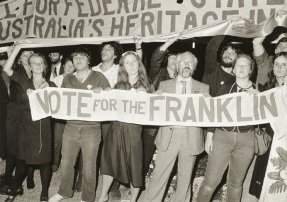The battle ends
You need to have the Flash Player installed in your browser in order to use the audio player.
During December 1981, the blockade began. Protestors in inflatable boats were stretched out across the Gordon River. The event was captured by television networks and viewed in many homes across Australia. Support rallies were also held around the country. The protest continued into January. Arrests occurred daily, including state and federal politicians. Many of those arrested refused to sign the bail conditions, which stated they could not return to the blockade. As a result they spent a further three weeks in prison. In disgust with this treatment a Tasmanian politician, Norm Sanders, resigned. As all this was happening, the World Heritage Commission accepted the nomination of the Tasmanian Southwest for heritage listing. This would play an important role in the upcoming High Court case.
You need to have the Flash Player installed in your browser in order to use the audio player.
As the protests continued, Fraser announced a federal election for March. On the same day, Bob Hawke became leader of the Labor opposition. He was against the dam in Tasmania. By March, over 1200 people had been arrested on the Franklin Dam blockade. With the impending federal election, the Tasmanian Wilderness Society and the Australian Conservation Foundation used hundreds of volunteers across the country to do the following:
Hawke only just won the election. An analysis showed that the conservation campaign had delivered crucial votes in marginal electorates. Once in power, Hawke announced that the dam would not go ahead. Premier Gray pressed ahead with the dam so the federal government introduced legislation to stop the work. Gray challenged this in the High Court. The High Court hearing began in 1983.
You need to have the Flash Player installed in your browser in order to use the audio player.
The case revolved around several major constitutional issues:
The federal government argued that under Section 51(xxix) of the Australian Constitution, which gives the Federal Parliament the power to make laws with regard to external affairs, they had a right to intervene in this area. As the southwest of Tasmania had been accepted as a world heritage area and as the Australian Government had ratified the international treaty, the Convention Concerning the Protection of the World Cultural and Natural Heritage, it was important they upheld the aims of this treaty by stopping the dam. The Tasmanian Government disagreed with this. They believed that allowing the Federal Government such broad new powers would infringe on the states' power to legislate in many areas, and would upset the federal/state balance. The Court agreed with the Federal Government and ruled by a majority of 4:3 that both the Act and the Proclamations were lawful. The Federal Government had the power to stop the dam. Gray was forced to withdraw the bulldozers and the Franklin River was saved. This was a significant case in Australian history confirming the federal government’s power to intervene. These powers were used later to protect Queensland’s Daintree rainforest and Tasmania’s Lemonthyme forest.
|
Franklin dam protestors at the Liberal Party Federal Election Campaign opening, 1983 |
